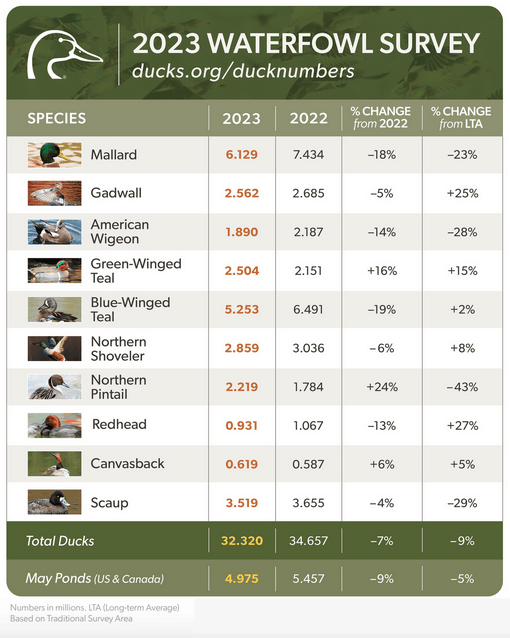The U.S. Fish and Wildlife Service has just published its report on the status of waterfowl population for 2023. This report is based on surveys conducted in May and early June, involving collaboration between the U.S. Fish and Wildlife Service, the Canadian Wildlife Service, and other partners. Total populations were estimated at 32.3 million.
Waterfowl Population Survey 2023: Sea Ducks

The report indicates that the total breeding duck population in the traditional survey area is estimated at 32.3 million, which reflects a 7% decrease from the 2022 estimate of 34.7 million. Furthermore, this figure is 9% below the long-term average since 1955.
Additionally, the report provides breeding population estimates for six common duck species groups in the Eastern Survey Area, which encompasses eastern Canada and northeastern states ranging from Virginia to Maine. The report also includes updates on the status of goose and swan populations.
Eastern Survey Area for Waterfowls Population

DU Chief Scientist Dr. Steve Adair explains that the current duck population numbers are the result of a complex interplay between waterfowl, weather, and habitat availability. Adair expressed some disappointment in these results, as there were hopes for better production in the prairies due to improved moisture conditions in the spring of 2022.
However, last year’s nesting season was affected by delays caused by April snowstorms and heavy May rains, which likely had an impact on overall duck production. Adair also noted that population growth can be delayed as small, shallow wetlands recover from the long-term effects of severe drought.
Key Takeaways
The 2023 Waterfowl Population Status report reveals several key findings:
- Overall, duck populations are still healthy and close to their long-term averages, offering a promising outlook for waterfowl hunters and enthusiasts this fall and winter.
- Total pond numbers in the U.S. and Canada were estimated at 5 million, slightly below the long-term average, which could have implications for waterfowl habitat.
- Mallard and American wigeon populations have declined, with mallards down 18% from 2022 and 23% from their long-term average, and American wigeon down 14% from 2022 and 28% from their long-term average. These declines are a concern and highlight the need for ongoing conservation efforts.
- Pintail populations showed a notable increase of 24% compared to the record low from the previous year.
- The report emphasizes the importance of wetlands conservation, especially given the ongoing loss of habitat across North America.
- The impact of highly pathogenic avian influenza (HPAI) outbreak of 2022 on duck populations is not expected to be significant based on reports from waterfowl managers and wildlife disease experts.
Ducks Unlimited CEO Adam Putnam stressed the importance of wetlands conservation and the need for sustained efforts to protect habitat and support healthy waterfowl populations.
You can access the full 2023 Waterfowl Population Status report from the U.S. Fish and Wildlife Service for more details.
What’s Next
The report explains ongoing concerns about habitat loss and degradation in the prairies, which have long-term impacts on the ability of waterfowl to breed, migrate, and winter successfully. Regardless of pond counts and precipitation, maintaining productive habitat throughout the waterfowl lifecycle is crucial.
Ducks Unlimited, along with partners like the U.S. Fish and Wildlife Service and various governmental, nonprofit, and corporate entities, has made significant strides in protecting and restoring waterfowl habitat. They have collectively conserved over 16 million acres of such habitat.
To further their understanding of waterfowl needs and conservation efforts, Ducks Unlimited continues to engage in innovative research projects. Additionally, private landowners, particularly farmers, play a vital role in maintaining healthy landscapes through voluntary incentive-based programs found in the U.S. Farm Bill.
Conservation efforts have yielded positive results over the decades. According to a recent State of the Birds report, waterfowl and other wetland-dependent bird species are the only group to have increased in numbers since the 1970s, largely due to these conservation initiatives.
Recognizing the need to invest in the future of wetlands and waterfowl populations, Ducks Unlimited, Ducks Unlimited Canada, Ducks Unlimited de Mexico, and Wetlands America Trust have launched “Conservation For a Continent,” a historic $3 billion capital campaign. This campaign represents one of the largest North American fundraising efforts aimed at supporting habitat protection and restoration.
Article Source: Ducks.org
Related Posts to Duck Calling
- Top 7 Tactics for Calling Ducks When Hunting in the Woods for a Kill
- Eight Duck Calls Every Duck Hunter Must Master this Hunting Season
- How to Remove a Hickey in Seconds Using Toothpaste
- How to Effectively Increase your Brain Power to Boost Study
- 100 Best White NBA Players in Basket Ball History in Pictures
- Find Your Dream Job Here to Launch Your Career – Future starts
- How Many Grams is in a Pound? Converter Grams, Pounds & Ounce







